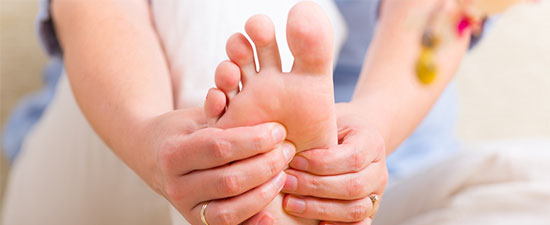- Home
- Foot & Ankle Conditions
- Diabetic Foot Conditions
Diabetic Foot Conditions
Why do diabetics have foot problems?
For diabetics, ordinary foot problems can quickly lead to infection and serious complications.
High blood sugar caused by poorly controlled diabetes can cause nerve damage (neuropathy) —especially to nerve cells in the feet. When nerves are damaged, they don’t accurately report pain to the brain.
Pain is our body's alarm system, letting us know that something needs attention. Without this vital sensory feedback, you might overlook a minor injury like a cut, blister, or sore. If left untreated, these small problems can become serious.
-
Foot and Ankle Surgeon and Director of University Foot and Ankle Institute
Dr. Bob Baravaria DPM, FACFAS is a Board-Certified Podiatric Foot and Ankle Specialist. He is an assistant clinical professor at the UCLA School of Medicine and serves as Director of University Foot and Ankle Institute.
Dr. Baravarian has been involved in athletics his entire life and played competitive tennis in high school and college. He has an interest in sports medicine, arthritis therapy, and trauma/reconstructive surgery of the foot and ankle. He is also fluent in five languages (English, French, Spanish, Farsi, and Hebrew),
Diabetic foot condition articles from our blog
- Common Foot Problems In Aging Feet: What To Watch Out For
- Neuropathy and Nerve Compression: Causes, Symptoms and Treatment
- Diabetic Foot Conditions: Charcot Foot
- Diabetic Foot Conditions: Osteomyelitis
- Why Diabetic Foot Exams Are Critically Important
- Do Your Burning Feet or Numb Toes Need to See a Doctor? Here's How to Know
- 6 Beach Bummers for Your Feet
 Excellent Service overall.Lisa C.
Excellent Service overall.Lisa C. Overall, it was a great experience. I've been coming to Dr. Kellman for about a year and he and his staff are very helpful.Vanessa W.
Overall, it was a great experience. I've been coming to Dr. Kellman for about a year and he and his staff are very helpful.Vanessa W. ExcellentDebasish M.
ExcellentDebasish M. Dr. Franson continues to be the best. Their office and staff are great and he is always gentle with injections, etc. Love it he...C M.
Dr. Franson continues to be the best. Their office and staff are great and he is always gentle with injections, etc. Love it he...C M. Everyone was friendly and professional.Victor L.
Everyone was friendly and professional.Victor L. Very efficient and an excellent serviceHorwitz J.
Very efficient and an excellent serviceHorwitz J. Chaos in the office checkin. We weren’t forewarned about the iPad data collection. That made me late for a following appointmen...Carl C.
Chaos in the office checkin. We weren’t forewarned about the iPad data collection. That made me late for a following appointmen...Carl C. Dr Nalbandian is an exceptional doctor and person. The staff respectfully & compently delt with an issue I had regarding a prev...Karen M.
Dr Nalbandian is an exceptional doctor and person. The staff respectfully & compently delt with an issue I had regarding a prev...Karen M. Visiting the office is a pleasurable occurance.Thomas J.
Visiting the office is a pleasurable occurance.Thomas J. Dr Kelman and his staff are always wonderfully caring and respectful to my father who has Alzheimer's dementia.Erland E.
Dr Kelman and his staff are always wonderfully caring and respectful to my father who has Alzheimer's dementia.Erland E. I couldn’t be more satisfied with Dr. Baravarian’s work. A few years ago, he performed surgery on my toe. He is now helping me ...Jean M.
I couldn’t be more satisfied with Dr. Baravarian’s work. A few years ago, he performed surgery on my toe. He is now helping me ...Jean M. Thank you for being there for your patients.Dieter B.
Thank you for being there for your patients.Dieter B.
-
 Listen Now
6 Beach Bummers for Your Feet
Read More
Listen Now
6 Beach Bummers for Your Feet
Read More
-
 Listen Now
Why Diabetic Foot Exams Are Critically Important
Read More
Listen Now
Why Diabetic Foot Exams Are Critically Important
Read More
-
 Listen Now
Do Your Burning Feet or Numb Toes Need to See a Doctor? Here's How to Know
Read More
Listen Now
Do Your Burning Feet or Numb Toes Need to See a Doctor? Here's How to Know
Read More
-
 Listen Now
Common Foot Problems In Aging Feet: What To Watch Out For
Read More
Listen Now
Common Foot Problems In Aging Feet: What To Watch Out For
Read More
-
 Listen Now
Diabetic Foot Conditions: Osteomyelitis
Read More
Listen Now
Diabetic Foot Conditions: Osteomyelitis
Read More
-
 Listen Now
Neuropathy and Nerve Compression: Causes, Symptoms and Treatment
Read More
Listen Now
Neuropathy and Nerve Compression: Causes, Symptoms and Treatment
Read More
-
 Listen Now
Diabetic Foot Conditions: Charcot Foot
Read More
Listen Now
Diabetic Foot Conditions: Charcot Foot
Read More








